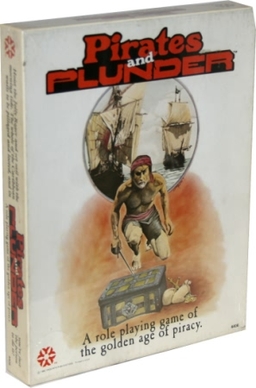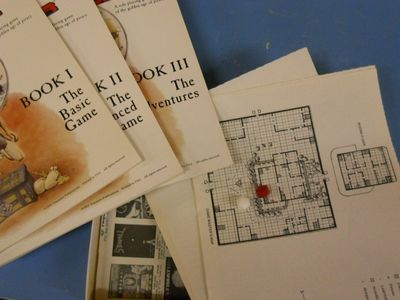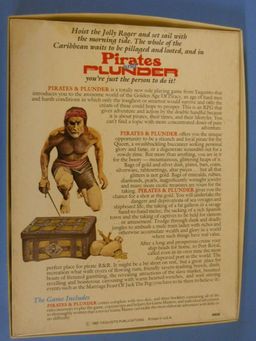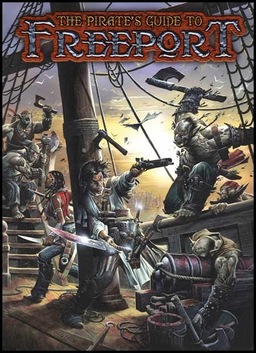Vintage Treasures: Pirates and Plunder
 Back in the early 80s, publishers were still exploring the boundless possibilities of role playing.
Back in the early 80s, publishers were still exploring the boundless possibilities of role playing.
It occurred to more than one designer that sword & sorcery — the tiny genre Gygax and Arneson had chosen to build their fabulously successful Dungeons & Dragons upon — was a niche market at best, with very limited widespread appeal.
Yet if D&D had managed to come so far with source material of such limited public familiarity, what might a game with much broader appeal accomplish?
And so the early 80s was a time when we had an astounding array of new role playing games promoted by a host of hopeful publishers, in a wide range of genres — science fiction, action, spy thrillers, mystery, superhero, and many others. There were gangster games (Gangbusters), Arthurian games (Pendragon), games based on popular action films (Indiana Jones, James Bond), and westerns (Boot Hill). There were horror games (Chill, Beyond the Supernatural), post-apocalyptic survival games (Twilight 2000, Gamma World), games based on prime time soap operas (SPI’s infamous Dallas), and bestsellers like Richard Adams’ Watership Down (Bunnies & Burrows).
Virtually all of them failed. Turns out that D&D didn’t succeed in spite of the fact that it drew inspiration from the classic heroic fantasy listed in the famous Appendix N, but in fact because of it. Sword & sorcery offered the kind of larger-than-life heroes players wanted to play — and more importantly, no other genre came so readily pre-packaged with a catalog of terrific opponents, from orcs to vampires to dragons.
But while most of those games are long forgotten today, a handful are still fondly remembered. Pirates and Plunder, a role playing game set in the golden age of piracy, is one of the latter. At least, it’s fondly remembered by me.
[Click on any of the images in this article for larger versions.]
 Pirates and Plunder had a few things going for it. For one thing, the designer chose his genre well. While many titles in that new flood of RPGs were greeted with skepticism, or sometimes open laughter (Gangbusters? Seriously?), most gamers saw the potential of a pirate RPG immediately. While we may not have been willing to drop D&D right away, we were at least curious about it.
Pirates and Plunder had a few things going for it. For one thing, the designer chose his genre well. While many titles in that new flood of RPGs were greeted with skepticism, or sometimes open laughter (Gangbusters? Seriously?), most gamers saw the potential of a pirate RPG immediately. While we may not have been willing to drop D&D right away, we were at least curious about it.
Another thing P&P had in its favor was its publisher. Yaquinto was a well-respected board gamer publisher in the 70s and 80s, and they were well known for clear rules and top-notch production values.
Pirates and Plunder was a fine example of both — inside the box were three books. The first, The Basic Game, outlined everything needed to play, including character generation and combat. The Advanced Game contained a host of options to enrich the experience — including mass combat tables, rules for drinking contests, sword fights, target shooting and arm wrestling, and even slapping contests. There were rules for muskets, and shooting from horseback. If you saw it portrayed on screen in Captain Blood or Treasure Island, chances are good it’s in the book.
It was the final volume was the most interesting to experienced players, though. The Adventures contained a linked series of adventures in the Spanish Main, beginning with a jail break that brings the characters together, and culminating in the events leading up to the wedding of the infamous Jack ‘The Peg,’ one of Port Royal’s most notorious and successful buccaneers. The 40-page adventure book includes a tightly-scripted sequence of action pieces that will thrust the players into a sea-battle against a well-armed fort, a desperate chase through a deadly jungle and treacherous swamp, and into the raucous underbelly of the pirate capital of Port Royal.
 In due course they will encounter an assortment of colorful characters, find a series of puzzling treasure maps, attempt to lead a bloodthirsty band of pirates, survive quicksand (or not), loot the town of Ciudad Vargas, steal a ship, battle sudden storms, and eventually go up against a well-armed cavalry brigade.
In due course they will encounter an assortment of colorful characters, find a series of puzzling treasure maps, attempt to lead a bloodthirsty band of pirates, survive quicksand (or not), loot the town of Ciudad Vargas, steal a ship, battle sudden storms, and eventually go up against a well-armed cavalry brigade.
Usually a new game would stand or fall on its introductory adventure. If it didn’t immediately appeal to players when they opened the box, they would usually seal it back up, put the box on the shelf, chalk it up as a bad purchase, and carry on with their regular Friday night D&D game, as usual.
But if that adventure fired their imagination they’d set aside that Friday game, make the investment in time and energy necessary to teach everyone a new set of rules, and see where this new role playing experience took them.
Not very many took that plunge with Pirates and Plunder, sadly. The game vanished without even a ripple. Most new RPGs in the early 80s had at least a few supplemental releases for their small pool of supporters; P&P didn’t even have that. There wasn’t so much as a follow-up adventure or even a GM shield. Which is a pity, as the grid-based movement and tightly-scripted mini-campaign were both fairly innovative for the time.
Pirates fans didn’t have much else to choose from. Fantasy Games Unlimited released Skull & Crossbones in 1980 (with a flimsy 32 pages of rules), and Privateers and Gentlemen in 1983. Somewhat more successful was their Flashing Blades release in 1984, which wasn’t strictly about pirates, but which had a High Seas supplement in 1985 that allowed for adventure in the Caribbean.
We had more luck with pirate-themed adventures and rules in a fantasy setting, such as Green Ronin’s excellent Freeport line, including The Pirates Guide to Freeport (2007). Most of those books are still in print, and I recommend them highly.
Why did Pirates and Plunder fail?
 Lots of reasons. As you can probably deduce, the market was pretty flooded with themed-releases at the time, all vying for our RPG dollar. Also, there was some criticism about the railroad nature of the adventure, and holes in the rules (including, oddly, ship-to-ship combat).
Lots of reasons. As you can probably deduce, the market was pretty flooded with themed-releases at the time, all vying for our RPG dollar. Also, there was some criticism about the railroad nature of the adventure, and holes in the rules (including, oddly, ship-to-ship combat).
But I don’t think any of that was fatal. And in the pirate theme and professional packaging, Yaquinto clearly had the foundations of a minor hit on their hands, especially if they had supported it properly.
No, I think the fatal flaw of Pirates & Plunder was more obvious. The three booklets within did a fine job of providing everything gamers raised on the Players Handbook and Dungeon Masters Guide expected — with one glaring exception.
Nowhere in any of those booklets was anything approximating a Monster Manual. With the exception of a snake coiling in wait in the swamp, your sole adversary in the lengthy and elaborate adventure was fellow pirates, and the Queen’s cavalry. There was no hint of anything like the supernatural in the rules — no cursed treasures, ghostly villains, or magical spyglasses.
That just wasn’t enough for players raised on Dungeons and Dragons. While the designers may have seen it as a noble effort to capture the pure swashbuckling fun of classic pirate novels and movies like Captain Blood, what we saw instead was a lack of imagination. There just wasn’t enough to keep our attention.
My copy went back on the shelf shortly after I opened it in 1982 — where it still sits, in mint, unused condition. I appreciated the fine design that went into it. But I knew what my player’s craved on Friday night, and Pirates and Plunder just wasn’t going to provide it for long.
Pirates and Plunder was designed by Michael S. Matheny and published by Yaquinto in 1982. The box contained three rules booklets, a thick pad of player character sheets, two dice, and around a dozen maps and player handouts. The original price was $19; I bought a second copy on eBay last week for $8.
Arrrgh. Keelhaul me for a lubber, I’d forgotten about that game, matey. I remember bringing me gold into Port Royal in the old Bloody Scupper and engaging in long, much-needed conversation with two or three accommodating ladies!
Hey Eric,
You may be the only person I’ve ever met who’s played this game!
And you’ve reminded me of another aspect of pirate RPGs… it was impossible to play them without slipping into pirate dialect. Four grown men, sitting around a table for three hours, talking like pirates… what more do you need for a riotously entertaining evening?
“many titles in that new flood of RPGs were greeted . . . sometimes open laughter (Gangbusters? Seriously?)”
I loved Gangbusters! The rule system was clunky, but I loved the overall concept.
Man, I love that Freeport stuff, even though I’ve never actually gotten to PLAY in it.
Yaquinto tanked the year after Pirates and Plunder was published, which certainly didn’t help. They had some good titles but P&P wasn’t going to be the breakthrough vehicle for them, even if the unpublished ship expansion module had come out. There were some great ideas in it, but the whole thing fell sort of flat when you actually tried playing it. Too scripted. Without the ship rules there wasn’t a lot there to support an ongoing campaign.
> I loved Gangbusters! The rule system was clunky, but I loved the overall concept.
James,
I guess I had the same problem with Gangbusters! as I did with Pirates and Plunder… I just couldn’t see it holding my interest for very long.
D&D hooked me with its each-to-understand concept: you overcame monsters, won experience, and your character leveled up. Adding richness and depth were the numerous different opponents to battle, and magic items to win.
Gangbuster has only one opponent (gangsters), and no magic items. To me, it was like a D&D campaign where all you ever fought was orcs, and where magic doesn’t work.
I’m happy to hear my impression was wrong, though. Other than the flaws with the rules system, did it manage to hold your interest?
> Man, I love that Freeport stuff, even though I’ve never actually gotten to PLAY in it.
Chris,
Agreed. It was a terrific line, with great art and an ambitious scope. I keep hoping to see more, in fact…
> Yaquinto tanked the year after Pirates and Plunder was published, which certainly didn’t help.
Chartmap,
I hadn’t realized the failure of the company came so close on the heels of the P&P release.
The death of Yaqunito was a hard blow. Their RPG line was hit-or-miss (I liked their Roman-era MAN, MYTH, & MAGIC), but their board games, like MYTHOLOGY and THE BEASTLORD, were a lot of fun, and I especially liked their album titles, like SWASHBUCKLER and HERO.
> They had some good titles but P&P wasn’t going to be the breakthrough vehicle for them, even if the unpublished ship expansion module had come out.
I wasn’t aware they had a ship expansion planned (although would have been a great idea!)
> There were some great ideas in it, but the whole thing fell sort of flat when you actually tried playing it. Too scripted.
> Without the ship rules there wasn’t a lot there to support an ongoing campaign.
No argument here. It made a fun read through, and I vividly remember thinking that my own campaign had a serious lack of pirates after I looked over the box.
If nothing else, P&P made me realize there were some great stories you could tell with a pirate campaign.
You should see what Yaquinto’s “album game” FRENCH FOREIGN LEGION is going for on eBay these days!
Even so, no way I’m selling my copy. It’s my favorite “Beer and Pretzels” wargame by miles.
My friends and I used the HERO system. We searched high and low for its pirate supplement – we found it and played several pretty fun pirate and sorcery campaigns inspired by Tim Powers’ ON STRANGER TIDES.
“Other than the flaws with the rules system, did [Gangbusters] manage to hold your interest?”
Not really. I played it a few times and went on to D&D as well. I do remember that the rules allowed you to play other “careers” besides gangsters. You could also play police, FBI, private investigator, or prohibition officers.
Interestingly, there was also a journalist career option, with some fairly in-depth rules concerning skills and how to acquire experience points. Nevertheless, being a reporter in a gangster game never sounded appealing to me.
Frankly, this was my experience with most TSR games other than D&D. We would play them a couple of times (e.g. Top Secret, Boot Hill, Gamma World, Indiana Jones, Marvel Super Heroes) and then go back to playing D&D.
One game we did play a lot of though, and I’d love to hear your thoughts on sometime, was Star Frontiers. That was a fun game!
> You should see what Yaquinto’s “album game” FRENCH FOREIGN LEGION is going for on eBay these days!
>
> Even so, no way I’m selling my copy. It’s my favorite “Beer and Pretzels” wargame by miles.
Eric,
How could I forget FRENCH FOREIGN LEGION was a Yaquinto game??
And yeah, I think it’s probably their most popular album game — and for good reason. It captures the spirit of Saturday afternoon adventure cinema like no other game I’ve ever seen.
Drew still cherishes that copy you gave him!
> My friends and I used the HERO system. We searched high and low for its pirate supplement
Fletcher — wait, what? There’s a pirate supplement to HERO?
No there isn’t. Is there? You mean PIRATES AND PLUNDER, right?
> One game we did play a lot of though, and I’d love to hear your thoughts on sometime, was Star Frontiers. That was a fun game!
James,
Never played STAR FRONTIERS. However, it’s one of Scott Taylor’s favorite RPGs, and he’s written about it a few times here at Black Gate:
http://www.blackgate.com/2011/04/13/art-of-the-genre-star-frontiers/
http://www.blackgate.com/2013/06/10/art-of-the-genre-the-top-10-role-playing-games-of-all-time/
John – there was indeed a Hero system supplement and it was published in 1990. I think I still have my copy in a box somewhere.